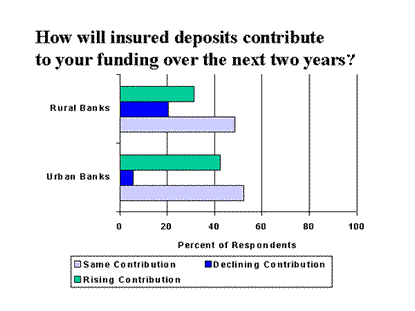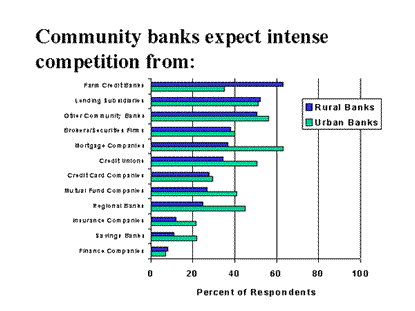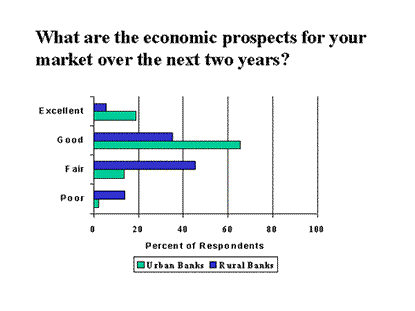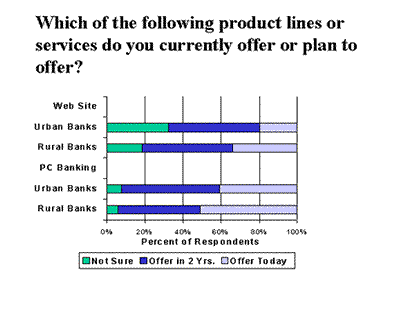At midyear, Ninth District community banks-despite different economic outlooks in rural and urban areas—face similar challenges. Both rural and urban community banks place a high priority on economic development, getting on the information highway and acquiring other community banks as important strategies if they are to grow and prosper. These are the primary conclusions to emerge from the fedgazette's fourth annual community banking poll, taken in March. Banks with less than $150 million in assets were surveyed, and of 688 banks contacted, 296 responded.
Bankers' concerns mirror economic conditions
Looking ahead to the next two years, more than half of rural community bankers indicated prospects for their communities were fair or poor, up from the 41 percent who expressed this opinion a year ago. In contrast, only 16 percent of urban community bankers in the current and previous surveys expressed this opinion. Much of rural respondents' current pessimism stems from low agricultural prices, as 82 percent stated that agriculture was very important to the performance of their loan portfolios. (For more on current agricultural conditions and banking see Agricultural Credit Conditions.)
Low agricultural prices are also driving people from rural communities, compounding rural banks' problems in attracting insured deposits to fund their loans. When asked to evaluate threats to their profitability, about half of both rural and urban community banks indicated that aging and declining population posed a high threat. It is, however, a greater threat for rural community banks as 55 percent of them are in counties that lost population in the 1990s, while only 8 percent of urban community banks' counties lost population. Urban banks are more hopeful than rural banks about the possible contribution of insured deposits in the coming years.

Community bank competition
Local economic conditions influence the competitive pressures that community banks face. As the accompanying chart shows, rural and urban community banks face competition that is pertinent to their particular markets, but they also share a common competitor-other community banks. About 50 percent of both urban and rural bank respondents rated other community banks and lending subsidiaries of commercial firms as offering intense competition.

Community economic development top priority
Both rural and urban banks have similar strategies for meeting upcoming challenges, despite the differences in their local economies. All respondents validated their designation as community banks: About 60 percent consider promoting their communities' economic development as a very important business strategy. Reflecting anxiety about the ability to attract insured deposits, both rural and urban banks also placed a high priority on increasing fee income. Fifty-four percent of rural respondents also rated improving risk management as a very important strategy, reflecting concern about the viability of their agricultural customers.

Community banks envision role on information highway
Although only a limited number of community banks currently offer PC banking or maintain an Internet site, they plan to substantially increase these offerings. Within two years around 50 percent of all respondents plan to offer PC banking, and 66 percent of rural community banks and 80 percent of urban community banks expect to have a Web site. (For more information see community banks on the Web.)

Another strategy for both urban and rural community banks involves expansion. Just under 20 percent of urban and rural banks see themselves acquiring other community banks in the next two years. Eight percent of rural community banks and 4 percent of urban community banks, however, expect to be acquired by either other community banks or large regional banks.
Facts about the survey
In March 688 Ninth District banks with assets less than $150 million in assets and which are not parts of a banking organization with assets in excess of $150 million were surveyed; 296 banks, or 43 percent, of the banks responded.
Respondents in this analysis have been classified as either rural or urban banks. Urban banks are the 96 respondents who are located in Metropolitan Statistical Area (MSA) counties or in the counties with urban populations of 2,500 or more adjacent to MSA counties. Rural banks are the 202 respondents who are located the district's remaining counties.





